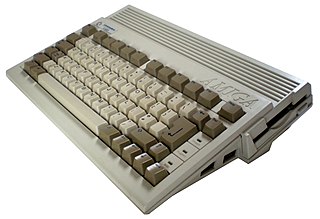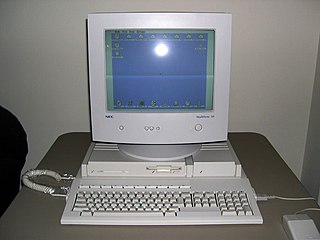See also
- SysSpeed
- Dhrystone
- FLOPS
- Kickstart (Amiga)
- Intuition (Amiga)
- AmigaDOS
- Amiga models and variants
- Instructions per second (IPS)
- Amiga Chip RAM
- Amiga custom chips (OCS, ECS, Agnus, Denise, Ramsey, Gary, etc.)
- Motorola 68000 family
| Original author(s) | Nic Wilson [1] |
|---|---|
| Developer(s) | Tobias Geijersson [2] |
| Stable release | |
| Written in | Assembly language (HiSoft Devpac) [1] |
| Operating system | AmigaOS 68k [1] |
| Available in | English |
| Type | Benchmark |
| License | Shareware [1] |
| Website | sysinfo |
Sysinfo is a shareware program written completely in Assembler for the Motorola 68k equipped Amiga computers to benchmark system performance. Sysinfo shows which version of system software is present in ROM, which hardware is present, and which operating mode the hardware uses.
SYSINFO V3.22 An Amiga System Information Program Written in Assembler Nic Wilsson Software P.O. Box 1164 Toowoomba Qld 4350 Australia SYSTEM SOFTWARE INSTALLED LIBRARIES INTERNAL HARDWARE MODES kickstart (512K) $00F80000 V37.350 Clock CLOCK NOT FOUND utility CHIP RAM $00000554 V37.3 DMA/Gfx ECS AGNUS - 2Meg graphics CHIP RAM $00002A68 V37.41 Mode NTSC:Hires keymap CHIP RAM $00006D68 V37.2 Display ECS DENISE layers CHIP RAM $000081D8 V37.9 CPU/MHz 68000 7.16 intuition CHIP RAM $00009984 V37.331 FPU NONE dos CHIP RAM $00011498 V37.45 MMU N/A VBR N/A SPEED COMPARISONS Comment What can I say! Dhrystones 519 You X Horiz KHz 15.72 A600 68000 7MHz 0.98 X EClock Hz 715909 B2000 68000 7MHz 0.74 X Ramsey rev N/A ICache N/A A1200 EC020 14MHz 0.42 XX Gary rev N/A DCache N/A A2500 68020 14MHz 0.25 XXX Card Slot YES IBurst N/A A3000 68030 25MHz 0.11 XXXXX Vert Hz 60 DBurst N/A A4000 68040 25MHz 0.02 XXXXXXXXXXXXXXX Supply Hz 60 CBack N/A CPU Mips 0.54 FPU MFlops N/A QUIT MEMORY BOARDS ICACHE IBURST CBACK Chip Speed vs A600 1.00 DRIVES SPEED PRINT DCACHE DBURST ALL
SYSINFO V4.0 An Amiga System Information Program Written in Assembler Contact address SysInfo@d0.se web page http://sysinfo.d0.se SYSTEM SOFTWARE INSTALLED LIBRARIES INTERNAL HARDWARE MODES kickstart (512K) $00F80000 V37.175 Clock CLOCK FOUND utility CHIP RAM $000007CC V37.3 DMA/Gfx STD AGNUS - 512K graphics CHIP RAM $00004258 V37.35 Mode PAL keymap CHIP RAM $00008548 V37.2 Display STD DENISE layers CHIP RAM $000099B8 V37.7 CPU/MHz 68000 7.09 intuition CHIP RAM $00009E5C V37.318 FPU NONE dos CHIP RAM $00012470 V37.44 MMU N/A VBR N/A SPEED COMPARISONS Comment What can I say! Dhrystones 539 You X Horiz KHz 15.60 A600 68000 7MHz 1.00 X EClock Hz 709379 B2000 68000 7MHz 0.77 X Ramsey rev N/A ICache N/A A1200 EC020 14MHz 0.44 XX Gary rev N/A DCache N/A A2500 68020 14MHz 0.26 XXX Card Slot NO IBurst N/A A3000 68030 25MHz 0.11 XXXXX Vert Hz 50 DBurst N/A A4000 68040 25MHz 0.02 XXXXXXXXXXXXXXX Supply Hz 50 CBack N/A Mips 0.56 MFlops N/A QUIT MEMORY BOARDS ICACHE IBURST CBACK Chip Speed vs A600 1.03 DRIVES SPEED PRINT DCACHE DBURST ALL

The Amiga 500, also known as the A500, is the first low-end Commodore Amiga 16/32-bit multimedia home/personal computer. It was announced at the winter Consumer Electronics Show in January 1987 – at the same time as the high-end Amiga 2000 – and competed directly against the Atari 520ST. Before it shipped Commodore suggested a list price of US$595.95 without a monitor. At delivery in October 1987 Commodore announced that the machine would carry a US$699/£499 list price.

The Commodore Amiga 500 Plus is an enhanced version of the original Amiga 500 computer. It was notable for introducing new versions of Kickstart and Workbench, and for some minor improvements in the custom chips, known as the Enhanced Chip Set.
The Enhanced Chip Set (ECS) is the second generation of the Amiga computer's chipset, offering minor improvements over the original chipset (OCS) design. ECS was introduced in 1990 with the launch of the Amiga 3000. Amigas produced from 1990 onwards featured a mix of OCS and ECS chips, such as later versions of the Amiga 500 and the Commodore CDTV. Other ECS models were the Amiga 500+ in 1991 and lastly the Amiga 600 in 1992.

The Motorola 68020 is a 32-bit microprocessor from Motorola, released in 1984. It is the successor to the Motorola 68010 and is succeeded by the Motorola 68030. A lower cost version was also made available, known as the 68EC020. In keeping with naming practices common to Motorola designs, the 68020 is usually referred to as the "020", pronounced "oh-two-oh" or "oh-twenty".

The Motorola 68030 ("sixty-eight-oh-thirty") is a 32-bit microprocessor in the Motorola 68000 family. It was released in 1987. The 68030 was the successor to the Motorola 68020, and was followed by the Motorola 68040. In keeping with general Motorola naming, this CPU is often referred to as the 030.

The Motorola 68040 ("sixty-eight-oh-forty") is a 32-bit microprocessor from Motorola, released in 1990. It is the successor to the 68030 and is followed by the 68060. There was no 68050. In keeping with general Motorola naming, the 68040 is often referred to as simply the '040.

The Motorola 68060 ("sixty-eight-oh-sixty") is a 32-bit microprocessor from Motorola released in 1994. It is the successor to the Motorola 68040 and is the highest performing member of the 68000 series. Two derivatives were produced, the 68LC060 and the 68EC060.

The Original Chip Set (OCS) is a chipset used in the earliest Commodore Amiga computers and defined the Amiga's graphics and sound capabilities. It was succeeded by the slightly improved Enhanced Chip Set (ECS) and greatly improved Advanced Graphics Architecture (AGA).

The Amiga 600, also known as the A600, is a home computer that was introduced at the CeBIT show in March 1992. The A600 is Commodore International's final model based on the Motorola 68000 CPU and the ECS chipset. It is essentially a redesign of the Amiga 500 Plus, with the option of an internal hard disk drive and a PCMCIA port. A notable aspect of the A600 is its small size. Lacking a numeric keypad, the A600 is only slightly larger than a standard PC keyboard. It shipped with AmigaOS 2.0, which was generally considered more user-friendly than earlier versions of the operating system.

The Commodore Amiga 3000, or A3000, is a personal computer released by Commodore in June 1990. It features improved processing speed, improved graphics rendering, and a new revision of the operating system. It is the successor to the Amiga 2000.

The Amiga 2000, or A2000, is a personal computer released by Commodore in March 1987. It was introduced as a "big box" expandable variant of the Amiga 1000 but quickly redesigned to share most of its electronic components with the contemporary Amiga 500 for cost reduction. Expansion capabilities include two 3.5" drive bays and one 5.25" bay that can be used by a 5.25" floppy drive, a hard drive, or CD-ROM once they became available.

UAE is a computer emulator which emulates the hardware of Commodore International's Amiga range of computers. Released under the GNU General Public License, UAE is free software.
Chip RAM is a commonly used term for the integrated RAM used in Commodore's line of Amiga computers. Chip RAM is shared between the central processing unit (CPU) and the Amiga's dedicated chipset. It was also, rather misleadingly, known as "graphics RAM".
Amiga Advanced Graphics Architecture (AGA) is the third-generation Amiga graphic chipset, first used in the Amiga 4000 in 1992. Before release AGA was codenamed Pandora by Commodore International.
The MOS Technology "Agnus", usually called Agnus, is an integrated circuit in the custom chipset of the Commodore Amiga computer. The Agnus, Denise and Paula chips collectively formed the OCS and ECS chipsets.

The Atari TT030 is a member of the Atari ST family, released in 1990. It was originally intended to be a high-end Unix workstation, but Atari took two years to release a port of Unix SVR4 for the TT, which prevented the TT from ever being seriously considered in its intended market.

The Motorola 68881 and Motorola 68882 are floating-point coprocessor (FPU) devices that were used in some computer systems in conjunction with the 68020 or 68030 microprocessors. The Motorola 68881 was introduced in 1984. The addition of one of these devices added substantial cost to a computer, but added a floating-point unit that could rapidly perform floating point mathematical calculations. In the mid 1980s, this feature was useful mostly for scientific and mathematical software.

Minimig is an open source re-implementation of an Amiga 500 using a field-programmable gate array (FPGA).
This was the last classic Amiga compatible chipset that Commodore announced in 1992. They planned to release it in 1994 for low-end Amiga computers along with AAA.
In addition to the Amiga chipsets, various specially designed chips have been used in Commodore Amiga computers that do not belong to the 'Amiga chipset' in a tight sense.